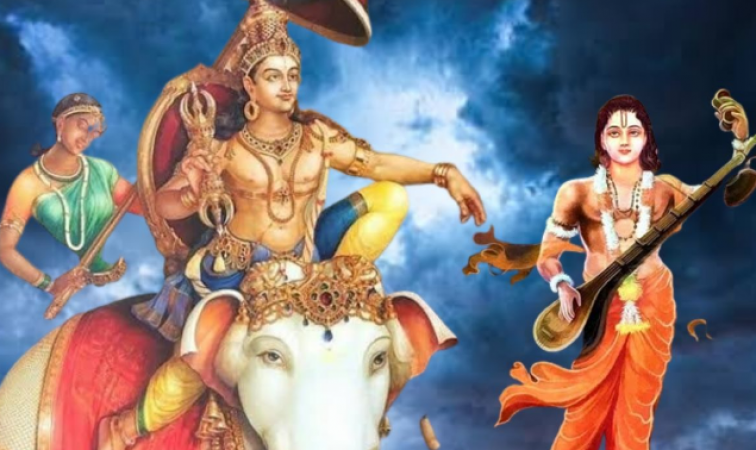
In Hindu mythology, Lord Indra holds a prominent place as the king of the gods and the ruler of the heavens. Known for his mighty thunderbolt, he is associated with rain, thunderstorms, and fertility. The worship of Lord Indra has been an integral part of Hinduism for centuries, and numerous temples have been built in his honor. In this article, we will delve into the history of Lord Indra, explore some of the famous temples dedicated to him, and discuss the rituals and rules followed during his worship.
Historical Background:
According to Hindu scriptures, Lord Indra is believed to be one of the Adityas, the celestial deities born from the womb of Aditi and sage Kashyapa. He is mentioned in the Rigveda, one of the oldest texts in Hinduism, dating back thousands of years. In the Rigveda, Lord Indra is depicted as a powerful warrior who defeats demons and protects the gods and mankind.
Lord Indra's Rise to Power:
The story of Lord Indra's rise to power is captivating. He was initially a mortal named Nahusha, who through his virtuous deeds and penance, earned the position of the king of gods. However, his arrogance led to his downfall, and he was replaced by Lord Indra, who assumed the role of the king of the gods. This tale highlights the importance of humility and righteousness, which are valued in the worship of Lord Indra.
Famous Temples Dedicated to Lord Indra:
Located in the serene town of Rudraprayag, this temple is dedicated to Lord Indra and is believed to be one of the oldest temples in the region. Devotees visit this temple to seek blessings for prosperity, success, and protection from natural calamities.
Indra Sabha, Rajasthan, India: Situated in Amer, near Jaipur, Indra Sabha is an exquisite temple dedicated to Lord Indra. It is known for its stunning architecture and intricate carvings that depict various mythological tales associated with Lord Indra.
Wat Phra Kaew, Thailand: This famous Buddhist temple in Bangkok houses the Emerald Buddha, which is highly revered in Thai culture. Lord Indra is often depicted as a guardian of the Buddha in Thai mythology, and his presence can be felt in this magnificent temple.
Worshipping Lord Indra: Worship of Lord Indra varies across regions and communities, but there are some common rituals and practices followed by devotees. Here are some essential aspects of worshiping Lord Indra:
Prayers and Mantras: Devotees chant specific mantras dedicated to Lord Indra, such as the Indra Gayatri mantra or the Indra Stotram, to invoke his blessings and seek his divine grace.
Offerings: Offerings play a significant role in worship. Devotees present flowers, fruits, sweets, and coconuts to Lord Indra as a symbol of devotion and gratitude. Some also offer rice, barley, or sugarcane to invoke fertility and abundance.
Rituals and Puja: Elaborate rituals are performed during the worship of Lord Indra, including the sacred bath (Abhishekam) with milk, water, or honey, followed by the application of sandalwood paste and vermilion (tilak). The lighting of incense sticks and the waving of lamps are common practices.
Fasting: Devotees often observe fasts on specific days dedicated to Lord Indra, such as Indra Ekadashi or Indra Chaturthi, to demonstrate their dedication and seek his blessings. Fasting is believed to purify the mind and body, enhancing the spiritual connection with the deity.
Celebrations and Festivals: Various festivals celebrate Lord Indra, such as Indra Purnima or Akasha Deepam, which are observed with great enthusiasm in different parts of India. These festivals involve processions, cultural events, and communal feasts to honor Lord Indra.
Rules and Guidelines for Worship: While the specific rules and guidelines for worshiping Lord Indra may vary, here are some common practices and considerations to keep in mind:
Purity and Cleanliness: Devotees are expected to maintain physical and mental purity before engaging in worship. Bathing and wearing clean clothes are essential. A calm and composed state of mind is also encouraged.
Respect and Reverence: Showing respect and reverence towards Lord Indra is vital during worship. Devotees should approach the deity with humility and devotion, recognizing his divine presence.
Regular Devotion: Consistency and regularity in worshiping Lord Indra are encouraged. Daily prayers, even if brief, demonstrate unwavering devotion and strengthen the bond between the devotee and the deity.
Faith and Surrender: Worshiping Lord Indra requires faith and surrender to his divine will. Devotees should cultivate trust in the power and benevolence of the deity, surrendering their desires and seeking spiritual enlightenment.
Lord Indra holds a significant position in Hindu mythology, symbolizing power, leadership, and protection. The worship of Lord Indra at various temples is a deeply ingrained aspect of Hindu culture, offering devotees an opportunity to connect with the divine and seek blessings. By understanding the rich history and mythology surrounding Lord Indra and following the prescribed rituals and guidelines, devotees can deepen their spiritual connection with this revered deity, experiencing a profound sense of devotion and fulfillment in their worship.
Swami Vivekananda: The world is the gymnasium of character formation
Who is Amogh Lila Das, a monk turned engineer, and why has Iskcon forbidden him?
Indian Rivers: India's only male river, which is also revered by people of other religions